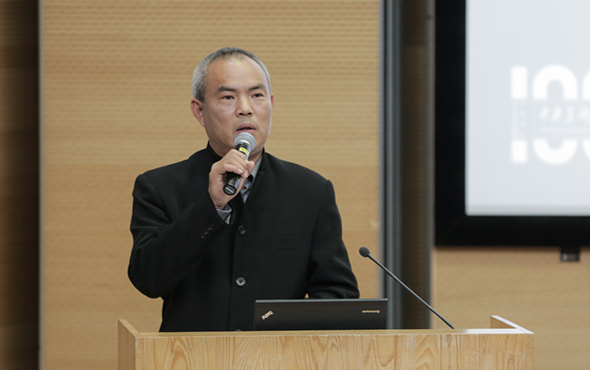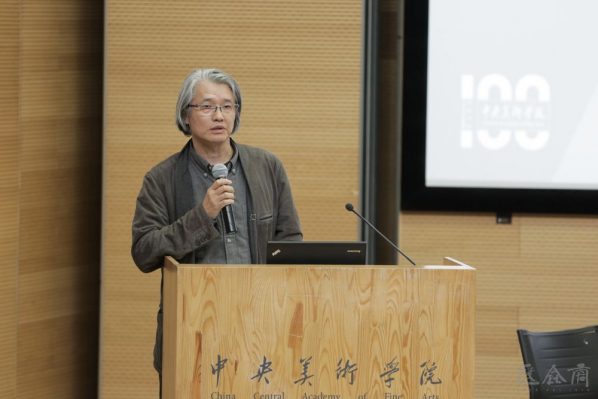
The closing ceremony was hosted by Lyu Pinjing, Vice President of the Central Academy of Fine Arts
At 6:00 pm on March 21, 2018, after two days of discussions and communications, the International Symposium of “Chinese Design 40 Years – Experience and Model” came to a successful conclusion. The closing ceremony was hosted by Lyu Pinjing, Vice President of the Central Academy of Fine Arts, who delivered a summary speech and said that the 25 honored guests had held discussions on four themes, including “Strategy & Decision”, “Culture & Choice”, “City & Creativity” and “Education & Future”, to review, edit, summarize and expect the great cause of Chinese design 40 years from different perspectives of design education. The whole forum reveals that we are now entering or have entered a new era of grand design. The design is both present and absent. It can be a concrete discipline and a means of practice. It can also break the barriers of all professions or practices and it can also be a very abstract idea or concept.
At the strategic level, with the start of a new journey in which China is moving toward building a modern socialist country, the wisdom and thinking of design has become a top-down national strategy that leads innovation. How to grasp and use this strategy is an important proposition related to future national development and people’s lives. At the cultural level, to a certain extent the development of Chinese design was a process of cultural choice after the reform and opening up. The choices are reflected in two aspects: on the one hand, our attitude towards our own cultural traditions, and on the other hand, the attitude toward external foreign cultures. How to choose, handle or coordinate these two attitudes will determine the direction of future Chinese design and design education to some extent.
On a practical level, Chinese design has a clear idea that creation or innovation is the eternal essence of design, after 40 years of development. The future Chinese design will rise abruptly based on the accumulated strength in every aspect of social life, after 40 years of accumulation in experiences and explorations of pattern, and emerging numerous Chinese samples; at an educational level, the future design is no longer confined to the division of discipline orientation, but moves towards the fusion of design.
After two-day communications and sharing of ideas, the honored guests reached a consensus on the topics related to Chinese design and formed a consistent view. During the symposium, the organizing committee of the symposium and the honored guests present at the symposium made a preliminary protocol and drew up the “China Design in the New Era: Beijing Consensus” (Discussion Draft) on the basis of a full exchange. Subsequently, Lyu Pinjing invited Liu Bo, Director of CAFA Institute of Art and Design, to read it out and the International Academic Symposium of “China Design for 40 Years – Experiences and Models” came to a successful conclusion.

Liu Bo, Director of CAFA Institute of Art and Design, read out “China Design in the New Era: Beijing Consensus” (Discussion Draft).
Attachment: “China Design in the New Era: Beijing Consensus” (Discussion Draft)
In 1978, China started the great process of reform and opening up, and Chinese design has also made considerable progress along with the development of the Chinese economy and society. As a participant and witness of this glorious history, we gathered at the Central Academy of Fine Arts in Beijing after 40 years, and sorted out the development context of Chinese design art and design education since the reform and opening up, summarizing the historical experience, standing at the beginning of a new era to think of and explore the future of Chinese design art and design education.
Chinese design took its first step 40 years ago, and now Chinese design has become the major part of the global design world when the “Made in China” was replaced by the “Created in China” 40 years later, and it has begun to lead the world in many areas. Obviously, Chinese design has made remarkable achievements in both the “scale” and “speed”, both the “quantity” and “quality”, in the past 40 years. What is particularly valuable is that many industrial clusters and educational institutions designed by China have accumulated a great deal of experiences in practice, and some have even formed a model that can be used for reference, and have a wide range of impacts.
After a rational, free and sufficient discussion of the distinguished guests of the symposium, we have reached the consensus as follows:
Firstly, the concept of “design” has tremendously changed, shifting from reality to virtualization, from shaping to experience, from products to services, etc., and these changes continue to happen at an alarming rate in the future. Today, the design has evolved into a “big design” in China. It is related to the enormous social needs that China has created as a big country that is prosperously developing and it also reflects the spirit of reform and exploration in the Chinese design community, reflecting the changes of concepts, and continuous practice in the era of China’s reform and opening up. Chinese design and design education must not stand still and refuse to make progress. We must maintain a high degree of concern for the new changes & new developments in the fields of economy, finance, science and technology and environment, continuing to occupy the highlands, explore the frontiers, to strive for the updating of the design concept of the scientific & technological design, ecological design, cross-border design, and humanistic design for the new era.
Secondly, although Chinese design has been integrated into the process of economic globalization many years ago, we have to make necessary adjustments to the world view and values of “Chinese Design” along with the new idea of Chinese globalization, such as “The Belt and Road Initiative”. We believe that Chinese designers should continue to be based on Chinese social practices and profound historical & cultural heritage, absorbing the knowledge and experiences of all humanity, and offer the world the Chinese wisdom and Chinese programs to deal with various crises & problems in the future from the perspective of design. Thirdly, we all agreed that we must continue to emphasize that design plays an important role in the development of the human economy, society, culture, and environment. The imbalance of economic development and social development, the gap of development between urban and rural areas, the alienation among all social classes, the continuous deterioration of natural & environmental conditions, the declining cultural diversity, and so on, all challenge the sustainable development of human civilization.
Fourthly, design education is about the future. We have realized that the imagination and vitality of the design thinking will be inevitably limited by the over-emphasizing professionalism. Today’s Chinese design should pay more attention to open minds and boundaries than ever, with a cross-border thinking that transcends specialization and an open-minded attitude, to promote the communication and collaboration among various fields and disciplines, so as to introduce new ideas and create new knowledge. At the same time, design education should be used as a form of education to cultivate innovative thinking and creativity throughout the life of a person rather than being limited to higher education and vocational education. We believe that while vigorously developing professional education in design, we should also improve the design literacy of the people, promoting a lifelong education in design, and introducing design to the classroom in primary and secondary schools, allowing design to become the core driving force for the cultivation of Chinese innovative quality and the important part of the entire social educational system.
Represented by Xi Jinping, General-Secretary of the Central Committee of the Communist Party of China (CPC), Party Central Committee proposes the “Five in One” general layout. A well-off society will be comprehensively built in China in 2020, the socialist modernization will be basically realized in 2035, and a modern powerful and socialist country will be built in the middle of this century, which points out a new direction for the reform and development of Chinese design and design education. There is an urgent demand for Chinese design to enable it to adapt to the inevitable requirement of adhering to and developing socialism with Chinese characteristics in the new era, to meet the growing needs of the people for a better life, promoting the economic & social development and the all-round social progress.
Standing at the starting point of a new era, Chinese design and design education has ushered in the strategic opportunities for the development of China’s society, as well as the challenges of economic globalization and the new collision, interweaving and blending with Chinese and foreign cultures. In short, the development of Chinese design is not only an important factor conducive to the realization of the great rejuvenation of the Chinese nation, and also an important force that promotes the sustainable development of human civilization and increases the well-being of humankind.
Text and photo courtesy of the organizer
Translated by Chen Peihua and edited by Sue/CAFA ART INFO




























